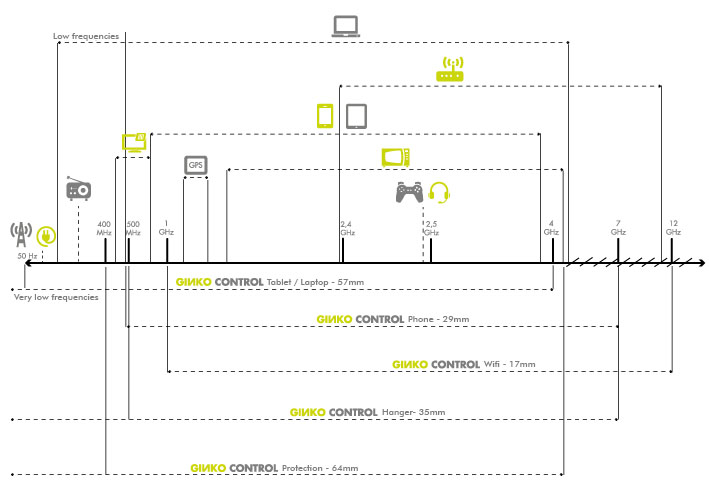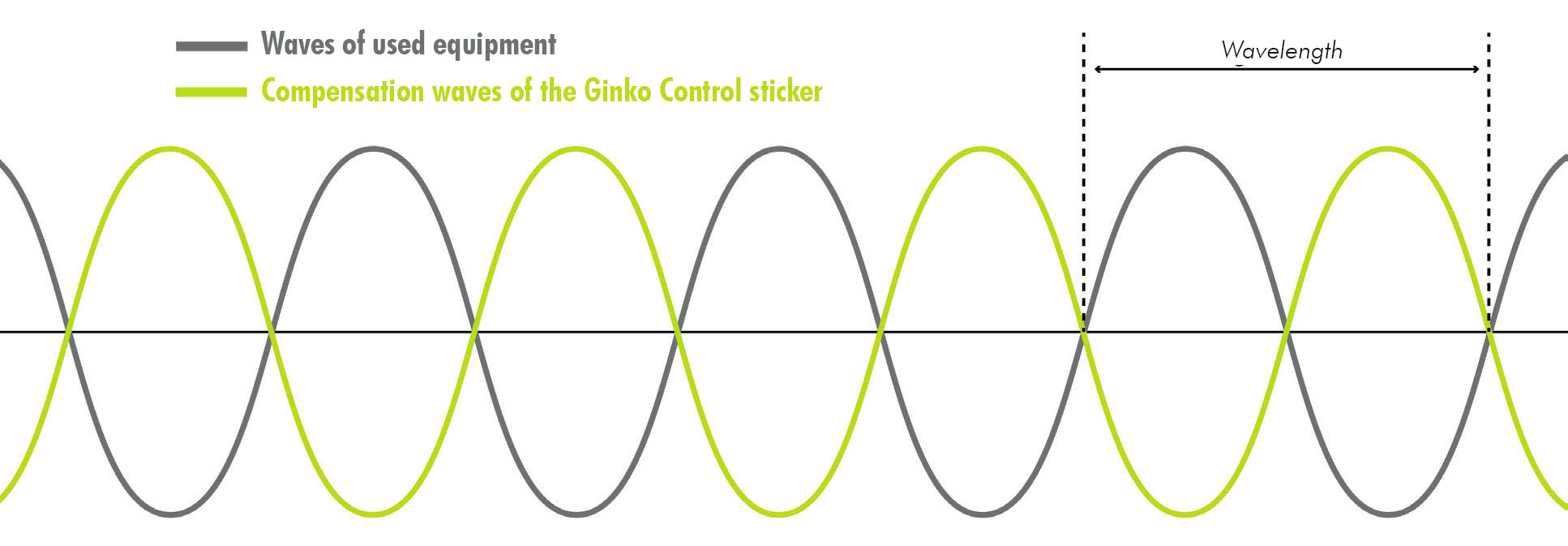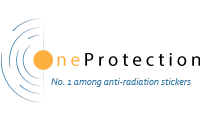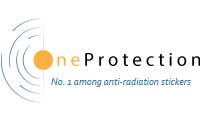180° phase shift diagram

In order to reduce the action of one force, it is enough to counteract its other force. The action will be neutralised if the two forces are equal in size but opposite. This is the principle of phase shift of 180°: 2 opposite waves of the same frequency neutralize each other.
The GINKO Control sticker is a passive electronic device consisting of a flexible shield supporting two identical antennas in opposite phases, separated by a dielectric isolating area. The first antenna captures the incoming wave (the so-called incident wave), of a specific phase. Thanks to the simple phenomenon of induction, the second antenna produces a wave of the same frequency, but shifted by 180° in phase. Therefore the second antenna emits a wave of the same frequency, shifted in phase by 180° at the moment when the first antenna transmits the falling wave not shifted in phase.
Diagram of phase shift by 180°
Observing this phenomenon on a two-channel oscilloscope gives a full picture of the phase shift overlapping: as in the case of the balancing two forces, positive and negative, which are exactly opposite each other, the same waves "stand in front of each other" and their oscillation result is zero.

GINKO Control tests
Scientific research and laboratory tests guarantee reliable operation of the GINKO Control sticker.
Many tests have already been carried out and more are in progress. All this to evaluate the effectiveness of the GINKO Control sticker. The test were conducted by: Professor ZANCA - MA in Astrophysics, engineer at INSA in Lyon with a doctorate in biochemistry, doctor of science (physics), doctor of medicine, biophysicist, specialist in nuclear medicine and magnetic resonance imaging at the University Hospital in Montpellier, Researcher in the physics laboratory of the University of Montpellier ((L2C, UMR5221 UM-CNRS) and Doctor GAUJAC - a graduate of the Faculty of Medicine and Pharmacy in Toulouse, hospital employee.
This cooperation includes both experimental verification of physical properties of stickers (demonstration of phase shift network and radio waves absorption at the output analyser) and their potential clinical effectiveness (tests of muscle efficiency during spatial balance (short-term "energy" tests of antigravitational muscles, long-term tests on postural platforms).
These laboratory tests allow to confirm some of the properties of stickers:
The GINKO Control sticker works on high bandwidth radio waves - for example, the GINKO Phone sticker works between 500 MHz and 7 GHz, thus covering 4G (832 MHz), but also GPS and satellite TV.
The GINKO Control sticker allowsin fact a phase shift of incoming electromagnetic waves by 180°.
Wearing the GINKO Control sticker relieves and reduces tension in the antigravitational muscle chains. In this way, the person regains energy levels that enable him/her to improve his/her physical performance and well-being.
Clinical tests clearly show a significant drop in energy when in close contact with devices emitting electromagnetic waves: the closer our body is to the sources of the waves, the more is exposed to electromagnetic environment.
Whenever energy losses were observed in the immediate vicinity of an electromagnetic radiation source, wearing the GINKO Control sticker enabled the recovery of the initial level, measured far from the mentioned source.
In addition, in order to determine the reactivity of entities to the GINKO Control Phone sticker and the GINKO Control sticker regulating properties, in February 2014, numerous electrophysiological studies were carried out (acupuncture, university hospital in Nîmes). The tests carried out with the use of BEST TM SYSTEM measuring equipment - MSA 21 - with double-blind test and placebo on over a hundred volunteers, were conducted together with M. Matthias JANSEN, Dr. D. PRAT PRADAL, University lecturer at the Faculty of Medicine MONTPELLIER-NIMES, head of the department dealing with functional examination of the nervous system and acupuncture at the University hospital CAREMEAU in NIMES.
These studies have shown that the GINKO Control sticker is a passive system that effectively and continuously "neutralises" the harmful effects of radio frequencies on the electrophysical potential of mobile phone users. The results of the above tests complement each other and confirm the effectiveness of the GINKO Control sticker. The results of these tests are reproducible.
Furthermore, the GINKO Control stickers are the only ones not showing any biological contraindications to influence both the high and low frequencies and to achieve controlled results.
All these key issues make GINKO Control the world's first choice.
Detailed test results are available on request, and the results of research conducted by Professor Zanca will be published in scientific journals.
FIND OUT MORE
Preliminary information
While the existence of negative health effects of radio frequencies is still not accepted by everyone, this issue is a cause for concern at some of the 'clinical manifestations', which are now becoming increasingly common and particularly acute for people called 'electro-sensitive'. Sleep disorders, headaches, arthritis, memory loss, stress.... The observation of these "health anomalies" leads to the consideration of the possibility of an organic cause related to the radio frequency electromagnetic environment and to the electrical properties of the human body. What is the role of radio-frequency electromagnetic waves in the occurrence of the abnormalities described above? Can we understand this mechanism? To what extent is it possible to reduce their effects? In order to solve these problems, GINKO France has developed passive stickers, the effectiveness of which has been tested and confirmed on the basis of objective evaluation of clinical parameters with "high variability". For example, the analysis of the degree of tension of antigravitational muscles responsible for maintaining body balance is one of the classic approaches in analytical medical semiotics. This approach can be "reversed" to understand the mechanism of immediate adaptation to temporary events that may affect the psychophysical condition of the subject; the quality of these adaptations may affect the overall health balance in the long term. Antigravitational muscles are often forced to adapt in such a way as to maintain the balance of the body in a standing position. Based on signals from numerous peripheral nerves, the brain controls the activities that are necessary to correct the abnormalities. Searching for asymmetry of tension in some postural muscles enables us to locate tensions and limitations in the mobilization of limbs and trunk, and to check whether this asymmetry persists with changes in the input stimuli into the nervous system. Regardless of the causes, the greater the body's energy requirements, the more difficult it will be to maintain a balance. Clinical evaluation of antigravitational muscle tension makes it possible to determine the energy characteristics appropriate for a person and to study the quality of adaptation to the environment in practically real time.
First question: is the intensity of the electromagnetic field around us increasing?
Yes, we artificially increase the intensity of the electromagnetic field by using more and more objects emitting radio frequency (RF) waves.
Second question: does the electromagnetic environment have any impact on the human body, and if so, is it nociceptive (unfavourable) or beneficial for our well-being?
Answer 1: Based on the results of antigravitational muscle tension studies, it can be concluded that strengthening the electromagnetic environment by carrying a smartphone or any other radio-connected device significantly reduces the tension in the antigravitational muscle chains, reflecting the nociceptive effect of the electromagnetic environment on our fitness;
Answer 2: A phone stops having a harmful effect if the distance from the body is "sufficient"; the distance depends on the individual and is on average over 60 cm, but is much greater in people who perceive themselves as "electrosensitive".
Third question: Does the electromagnetic environment in which we currently live affect the antigravitational muscle chains even when we are away from wave emitting devices?
The finding in the Faraday cage, where there are no electromagnetic waves, of a clear reduction in tension in the antigravitational muscle chains, reflecting a significant increase in muscle efficiency, shows that the current increase in electromagnetic waves around us is already having a significant adverse effect on the human body.
Fourth question: what is the role of the GINKO Control® sticker in this situation?
When the 29 mm diameter sticker is placed a phone worn with you, it completely restores the level of muscle efficiency achieved in the Faraday cage. This effect is not achieved by placing the placebo in place of the sticker. Thus, still based on the work of antigravitational muscles, it turns out that the GINKO Control® sticker almost completely eliminates the negative impact of the electromagnetic environment. Maintaining muscle performance can be considered as the general property of GINKO Control® stickers, which is to protect living organisms from certain (unfavourable) effects of the electromagnetic environment, regardless of its severity.
Question 5: How does it work?
The supportive effects of GINKO Control to the human body may be associated, at least in part, with the passive phase shift of 180° intended by the creators, but it is possible that other mechanisms also have an impact on it, which is currently being studied.
Example: measurements taken during a double-blind study (GINKO Control® or placebo sticker) on 30 volunteers who have been informed of the possible effects and have given their informed consent

